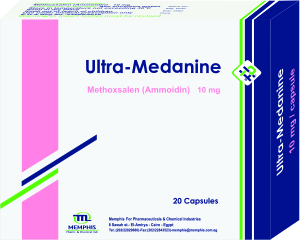GENERIC NAME: Methoxsalen (Ammoidin) COMPOSITION: Each capsule contains: Active ingredient: Methoxsalen (Ammoidin) 10 mg USP Excipients: Carbowax 4000, polysorbate 80, Avicel PH 102. Composition of capsule shell (size one): Cap (transparent): gelatin. Body (transparent): gelatin. PHARMACEUTICAL FORM: Hard gelatin capsules, colorless cap and colorless body containing white to creamy white granular powder. Rx ONLY CAUTION: METHOXSALEN IS A POTENT DRUG. READ ENTIRE BROCHURE PRIOR TO PRESCRIBING OR DISPENSING THIS MEDICATION. CAUTION: 8-MOP Capsules (Methoxsalen Hard Gelatin Capsules) may not be interchanged with Oxsoralen-Ultra Capsules (Methoxsalen Soft Gelatin Capsules) without retitration of the patient. I. DESCRIPTION ULTRA-MEDANINE (methoxsalen, 8-methoxypsoralen) Capsules, 10 mg. Methoxsalen is a naturally occurring photoactive substance found in the seeds of the Ammi majus (Umbelliferae) plant and in the roots of Heracleum Candicans. It belongs to a group of compounds known as psoralens, or furocoumarins. II. CLINICAL PHARMACOLOGY The combination treatment regimen of psoralen (P) and ultraviolet radiation of 320–400 nm wavelength commonly referred to as UVA is known by the acronym, PUVA. Skin reactivity to UVA (320–400 nm) radiation is markedly enhanced by the ingestion of methoxsalen. The drug reaches its maximum bioavailability 1 1/2–3 hours after oral administration and may last for up to 8 hours (Pathak et al. 1974)1. Methoxsalen is reversibly bound to serum albumin and is also preferentially taken up by epidermal cells (Artuc et al. 1979). At a dose which is six times larger than that used in humans, it induces mixed function oxidases in the liver of mice (Mandula et al. 1978). In both mice and man, methoxsalen is rapidly metabolized. Approximately 95% of the drug is excreted as a series of metabolites in the urine within 24 hours (Pathak et al. 1977). The exact mechanism of action of methoxsalen with the epidermal melanocytes and keratinocytes is not known. The best known biochemical reaction of methoxsalen is with DNA. Methoxsalen, upon photoactivation, conjugates and forms covalent bonds with DNA which leads to the formation of both monofunctional (addition to a single strand of DNA) and bifunctional adducts (crosslinking of psoralen to both strands of DNA) (Dall’Acqua et al., 1971; Cole, 1970; Musajo et al., 1974; Dall’Acqua et al., 1979). Reactions with proteins have also been described (Yoshikawa, et al., 1979). Methoxsalen acts as a photosensitizer. Administration of the drug and subsequent exposure to UVA can lead to cell injury. Orally administered methoxsalen reaches the skin via the blood and UVA penetrates well into the skin. If sufficient cell injury occurs in the skin, an inflammatory reaction occurs. The most obvious manifestation of this reaction is delayed erythema, which may not begin for several hours and peaks at 48–72 hours. The inflammation is followed, over several days to weeks, by repair which is manifested by increased melanization of the epidermis and thickening of the stratum corneum. The mechanisms of therapy are not known. In the treatment of vitiligo, it has been suggested that melanocytes in the hair follicle are stimulated to move up the follicle and to repopulate the epidermis (Ortonne et al, 197910). In the treatment of psoriasis, the mechanism is most often assumed to be DNA photodamage and resulting decrease in cell proliferation but other vascular, leukocyte, or cell regulatory mechanisms may also be playing some role. Psoriasis is a hyperproliferative disorder and other agents known to be therapeutic for psoriasis are known to inhibit DNA synthesis. III. INDICATIONS AND USAGE A. Photochemotherapy (Methoxsalen with long wave UVA radiation) is indicated for the symptomatic control of severe, recalcitrant, disabling psoriasis not adequately responsive to other forms of therapy and when the diagnosis has been supported by biopsy. Methoxsalen is intended to be administered only in conjunction with a schedule of controlled doses of long wave ultraviolet radiation. B. Photochemotherapy (methoxsalen with long wave ultraviolet radiation) is indicated for the repigmentation of idiopathic vitiligo. C. Photopheresis (methoxsalen with long wave ultraviolet radiation of white blood cells) is indicated for use with the UVAR* System in the palliative treatment of the skin manifestations of cutaneous T-cell lymphoma (CTCL) in persons who have not been responsive to other forms of treatment. While this dosage form of methoxsalen has been approved for use in combination with photopheresis, Methoxsalen as soft Capsules have not been approved for that use. IV. CONTRAINDICATIONS A. Patients exhibiting idiosyncratic reactions to psoralen compounds. B. Patients possessing a specific history of light sensitive disease states should not initiate methoxsalen therapy except under special circumstances. Diseases associated with photosensitivity include lupus erythematosus, porphyria cutanea tarda, erythropoietic protoporphyria, variegate porphyria, xeroderma pigmentosum, and albinism. C. Patients with melanoma or with a history of melanoma. D. Patients with invasive squamous cell carcinomas. E. Patients with aphakia, because of the significantly increased risk of retinal damage due to the absence of lenses
